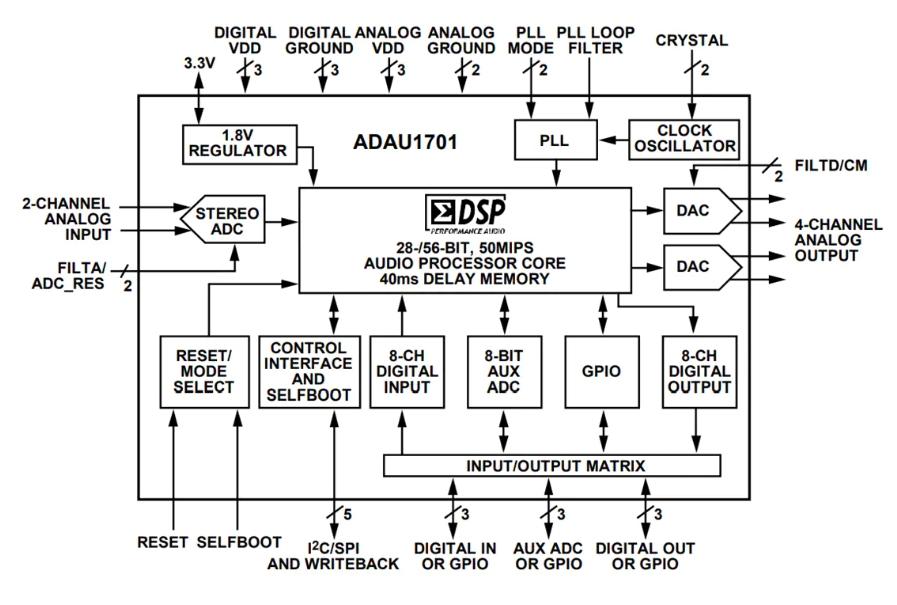The ADAU1701 is a highly integrated audio Digital Signal Processor (DSP) designed by Analog Devices. It is optimized for audio processing applications, providing a comprehensive solution for high-performance audio processing with minimal power consumption. This article will delve into the features, applications, and functional block diagram of the ADAU1701, offering a thorough understanding of its capabilities and uses.
Features of the ADAU1701
The ADAU1701 is packed with features that make it a versatile and powerful choice for audio processing. Key features include:
-
SigmaDSP Core: The heart of the ADAU1701 is its SigmaDSP core, which enables real-time processing of audio signals. It supports a wide range of algorithms, including filtering, dynamics processing, equalization, and more.
-
Integrated ADCs and DACs: The ADAU1701 includes two 24-bit analog-to-digital converters (ADCs) and four 24-bit digital-to-analog converters (DACs), providing high-quality audio conversion for both input and output signals.
-
Flexible Audio Interface: The device supports a range of digital audio interfaces, including I2S, TDM, and PCM, allowing it to interface seamlessly with other audio components in a system.
-
On-Chip Memory: The ADAU1701 comes with on-chip RAM for storing program instructions and data. This reduces the need for external memory and simplifies the system design.
-
Self-Boot Capability: The ADAU1701 can automatically load its program and settings from an external EEPROM upon power-up, enabling standalone operation without the need for a microcontroller.
-
Low Power Consumption: The ADAU1701 is designed to operate with low power consumption, making it ideal for battery-powered and portable devices.
-
Graphical Programming: The DSP is supported by Analog Devices' SigmaStudio software, a graphical programming environment that simplifies the development of audio processing algorithms without requiring extensive DSP programming knowledge.
-
Multiband Parametric Equalization: The ADAU1701 supports multiband parametric equalization, which is essential for audio applications requiring fine-tuned sound quality.
-
Dynamic Bass Boost: The DSP features dynamic bass boost, enhancing low-frequency performance in audio systems.
-
Multichannel Audio Processing: The ADAU1701 supports multichannel audio processing, making it suitable for applications like surround sound systems.
Applications of the ADAU1701
The ADAU1701 is used in a variety of audio processing applications due to its flexibility, low power consumption, and high-quality audio performance. Common applications include:
-
Consumer Audio Devices: The ADAU1701 is widely used in consumer audio devices, such as home theater systems, soundbars, and portable speakers, where high-quality audio processing is essential.
-
Professional Audio Equipment: In professional audio gear, like mixers, audio interfaces, and studio monitors, the ADAU1701 provides precise and customizable audio processing capabilities.
-
Automotive Audio Systems: The ADAU1701 is employed in automotive audio systems to enhance the listening experience by offering features like noise reduction, equalization, and dynamic bass boost.
-
Hearing Aids and Assistive Listening Devices: Due to its low power consumption and high-quality processing, the ADAU1701 is used in hearing aids and assistive listening devices to improve speech intelligibility and overall audio clarity.
-
Musical Instruments and Effects: The DSP is utilized in digital musical instruments and audio effects processors, where it helps in shaping and enhancing sound quality.
-
Broadcast and Communication Systems: The ADAU1701 is also used in broadcast and communication systems for tasks like audio compression, noise reduction, and signal enhancement.
Functional Block Diagram of the ADAU1701

The functional block diagram of the ADAU1701 provides a visual overview of its internal architecture, highlighting the various components and how they interact. The key blocks in the ADAU1701 include:
-
SigmaDSP Core: At the center of the ADAU1701 is the SigmaDSP core, responsible for executing audio processing algorithms. This core handles tasks like filtering, dynamics processing, and equalization.
-
Analog-to-Digital Converters (ADCs): The ADAU1701 features two high-performance ADCs that convert analog input signals into digital data for processing by the SigmaDSP core.
-
Digital-to-Analog Converters (DACs): The device includes four DACs that convert processed digital audio signals back into analog form for output.
-
Input and Output Serial Ports: The ADAU1701 includes serial ports for input and output, supporting interfaces like I2S, TDM, and PCM. These ports allow the DSP to communicate with other digital audio devices.
-
Program and Parameter Memory: The on-chip RAM stores program instructions and audio processing parameters, enabling the DSP to execute complex algorithms without the need for external memory.
-
Control Interface: The control interface allows external devices, like microcontrollers or host processors, to communicate with and configure the ADAU1701. This interface supports I2C and SPI communication protocols.
-
Power Management: The power management block ensures that the ADAU1701 operates efficiently, managing power distribution to various internal components.
-
Self-Boot Circuitry: The self-boot circuitry enables the ADAU1701 to load its program and settings from an external EEPROM upon power-up, allowing it to operate autonomously.
Conclusion
The ADAU1701 is a powerful and flexible DSP tailored for high-performance audio processing applications. Its rich feature set, including integrated ADCs and DACs, low power consumption, and graphical programming support, makes it a go-to solution for a wide range of audio applications, from consumer electronics to professional audio gear. Understanding its features, applications, and functional block diagram provides a solid foundation for leveraging the ADAU1701 in various audio processing tasks.
Facts Checked by Hugh Johnson
Hugh Johnson stands tall in the realms of both the Integrated Circuits (ic Chips) industry and the electronic parts industry, earning acclaim as an esteemed expert in these fields. With an extensive background steeped in semiconductor technology, Hugh's expertise transcends chip design and fabrication, encompassing a profound understanding of electronic components' intricate functionalities and applications. His seasoned knowledge spans diverse facets, from microchip architecture and fabrication techniques to the broader landscape of electronic parts utilized across industries.











